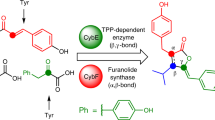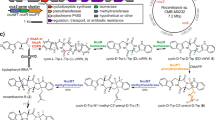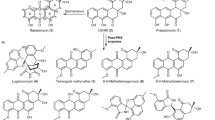Abstract
Alkylation of aromatic rings with alkyl halides is an important transformation in organic synthesis, yet an enzymatic equivalent is unknown. Here, we report that cylindrocyclophane biosynthesis in Cylindrospermum licheniforme ATCC 29412 involves chlorination of an unactivated carbon center by a novel halogenase, followed by a previously uncharacterized enzymatic dimerization reaction featuring sequential, stereospecific alkylations of resorcinol aromatic rings. Discovery of the enzymatic machinery underlying this unique biosynthetic carbon–carbon bond formation has implications for biocatalysis and metabolic engineering.
This is a preview of subscription content, access via your institution
Access options
Access Nature and 54 other Nature Portfolio journals
Get Nature+, our best-value online-access subscription
$29.99 / 30 days
cancel any time
Subscribe to this journal
Receive 12 print issues and online access
$259.00 per year
only $21.58 per issue
Buy this article
- Purchase on Springer Link
- Instant access to full article PDF
Prices may be subject to local taxes which are calculated during checkout




Similar content being viewed by others
References
Friedel, C. & Crafts, J.M. Sur une nouvelle méthode générale de synthèse d'hydrocarbures, d'acétones, etc. Comptes rendus des séances 84, 1392–1395 (1877).
Reddy, V.P. & Prakash, G.K.S. Friedel-Crafts Reactions. In Kirk-Othmer Encyclopedia of Chemical Technology (John Wiley & Sons, Inc., 2000).
Moore, B.S. et al. [7.7]Paracyclophanes from blue-green algae. J. Am. Chem. Soc. 112, 4061–4063 (1990).
Chen, J.L., Moore, R.E. & Patterson, G.M.L. Structures of nostocyclophanes A-D. J. Org. Chem. 56, 4360–4364 (1991).
Moore, B.S., Chen, J.L., Patterson, G.M.L. & Moore, R.E. Structures of cylindrocyclophanes A-F. Tetrahedron 48, 3001–3006 (1992).
Bui, H.T.N., Jansen, R., Pham, H.T.L. & Mundt, S. Carbamidocyclophanes A-E, chlorinated paracyclophanes with cytotoxic and antibiotic activity from the Vietnamese cyanobacterium Nostoc sp. J. Nat. Prod. 70, 499–503 (2007).
Chlipala, G.E. et al. Cylindrocyclophanes with proteasome inhibitory activity from the Cyanobacterium Nostoc sp. J. Nat. Prod. 73, 1529–1537 (2010).
Kang, H.-S. Merocyclophanes A and B, antiproliferative cyclophanes from the cultured terrestrial Cyanobacterium Nostoc sp. Phytochemistry 79, 109–115 (2012).
Luo, S. et al. Carbamidocyclophanes F and G with anti-Mycobacterium tuberculosis activity from the cultured freshwater cyanobacterium Nostoc sp. Tetrahedr. Lett. 55, 686–689 (2014).
Preisitsch, M. et al. Anti-MRSA-acting carbamidocyclophanes H-L from the Vietnamese cyanobacterium Nostoc sp. CAVN2. J. Antibiot. 68, 165–177 (2015).
Preisitsch, M. et al. Effects of halide ions on the Carbamidocyclophane biosynthesis in Nostoc sp. CAVN2. Mar. Drugs 14, 21 (2016).
May, D.S. et al. Merocyclophanes C and D from the cultured freshwater cyanobacterium Nostoc sp. (UIC 10110). J. Nat. Prod. 80, 1073–1080 (2017).
Bobzin, S.C. & Moore, R.E. Biosynthetic origin of [7.7]paracyclophanes from cyanobacteria. Tetrahedron 49, 7615–7626 (1993).
Nakamura, H., Hamer, H.A., Sirasani, G. & Balskus, E.P. Cylindrocyclophane biosynthesis involves functionalization of an unactivated carbon center. J. Am. Chem. Soc. 134, 18518–18521 (2012).
Nakamura, H., Wang, J.X. & Balskus, E.P. Assembly line termination in cylindrocyclophane biosynthesis: discovery of an editing type II thioesterase domain in a type I polyketide synthase. Chem. Sci. 6, 3816–3822 (2015).
Sydor, P.K. et al. Regio- and stereodivergent antibiotic oxidative carbocyclizations catalysed by Rieske oxygenase-like enzymes. Nat. Chem. 3, 388–392 (2011).
Choi, Y.S., Zhang, H., Brunzelle, J.S., Nair, S.K. & Zhao, H. In vitro reconstitution and crystal structure of p-aminobenzoate N-oxygenase (AurF) involved in aureothin biosynthesis. Proc. Natl. Acad. Sci. USA 105, 6858–6863 (2008).
Zocher, G., Winkler, R., Hertweck, C. & Schulz, G.E. Structure and action of the N-oxygenase AurF from Streptomyces thioluteus. J. Mol. Biol. 373, 65–74 (2007).
Nordlund, P. & Eklund, H. Di-iron-carboxylate proteins. Curr. Opin. Struct. Biol. 5, 758–766 (1995).
Okino, T., Matsuda, H., Murakami, M. & Yamaguchi, K. Microginin, an angiotensin converting enzyme inhibitor from the blue-green alga Microcystis aeruginosa. Tetrahedr. Lett. 34, 501–504 (1993).
Kodani, S., Suzuki, S., Ishida, K. & Murakami, M. Five new cyanobacterial peptides from water bloom materials of lake Teganuma (Japan). FEMS Microbiol. Lett. 178, 343–348 (1999).
Ishida, K., Matsuda, H. & Murakami, M. Four new microginins, linear peptides from the cyanobacterium Microcystis aeruginosa. Tetrahedron 54, 13475–13484 (1998).
Kramer, D. Microginin producing proteins and nucleic acids encoding a microginin gene cluster as well as methods for creating novel microginins. US patent 7,846,686B2 (2010).
Leão, P.N. et al. Biosynthesis-assisted structural elucidation of the bartolosides, chlorinated aromatic glycolipids from cyanobacteria. Angew. Chem. Int. Ed. Engl. 54, 11063–11067 (2015).
Kleigrewe, K. et al. Combining mass spectrometric metabolic profiling with genomic analysis: a powerful approach for discovering natural products from cyanobacteria. J. Nat. Prod. 78, 1671–1682 (2015).
Wagner, C., El Omari, M. & König, G.M. Biohalogenation: nature's way to synthesize halogenated metabolites. J. Nat. Prod. 72, 540–553 (2009).
Preisitsch, M. et al. Cylindrofridins A–C, linear cylindrocyclophane-related alkylresorcinols from the cyanobacterium Cylindrospermum stagnale. J. Nat. Prod. 79, 106–115 (2016).
Pfeifer, B.A., Admiraal, S.J., Gramajo, H., Cane, D.E. & Khosla, C. Biosynthesis of complex polyketides in a metabolically engineered strain of E. coli. Science 291, 1790–1792 (2001).
Nakano, C., Funa, N., Ohnishi, Y. & Horinouchi, S. The O-methyltransferase SrsB catalyzes the decarboxylative methylation of alkylresorcylic acid during phenolic lipid biosynthesis by Streptomyces griseus. J. Bacteriol. 194, 1544–1551 (2012).
Linhartová, I. et al. RTX proteins: a highly diverse family secreted by a common mechanism. FEMS Microbiol. Rev. 34, 1076–1112 (2010).
Slack, F.J. & Ruvkun, G. A novel repeat domain that is often associated with RING finger and B-box motifs. Trends Biochem. Sci. 23, 474–475 (1998).
Smith, A.B. III., Kozmin, S.A. & Paone, D.A. Total synthesis of (−)-cylindrocyclophane F. J. Am. Chem. Soc. 121, 7423–7424 (1999).
Yeh, E., Garneau, S. & Walsh, C.T. Robust in vitro activity of RebF and RebH, a two-component reductase/halogenase, generating 7-chlorotryptophan during rebeccamycin biosynthesis. Proc. Natl. Acad. Sci. USA 102, 3960–3965 (2005).
Magarvey, N.A. et al. Biosynthetic characterization and chemoenzymatic assembly of the cryptophycins. Potent anticancer agents from cyanobionts. ACS Chem. Biol. 1, 766–779 (2006).
Galonić, D.P., Vaillancourt, F.H. & Walsh, C.T. Halogenation of unactivated carbon centers in natural product biosynthesis: trichlorination of leucine during barbamide biosynthesis. J. Am. Chem. Soc. 128, 3900–3901 (2006).
Hillwig, M.L. & Liu, X. A new family of iron-dependent halogenases acts on freestanding substrates. Nat. Chem. Biol. 10, 921–923 (2014).
Nowak-Thompson, B. et al. 2,5-dialkylresorcinol biosynthesis in Pseudomonas aurantiaca: novel head-to-head condensation of two fatty acid-derived precursors. J. Bacteriol. 185, 860–869 (2003).
Vaillancourt, F.H., Yeh, E., Vosburg, D.A., O'Connor, S.E. & Walsh, C.T. Cryptic chlorination by a non-haem iron enzyme during cyclopropyl amino acid biosynthesis. Nature 436, 1191–1194 (2005).
Gu, L. et al. Metamorphic enzyme assembly in polyketide diversification. Nature 459, 731–735 (2009).
Neumann, C.S., Fujimori, D.G. & Walsh, C.T. Halogenation strategies in natural product biosynthesis. Chem. Biol. 15, 99–109 (2008).
Chankhamjon, P. et al. Regioselective dichlorination of a non-activated aliphatic carbon atom and phenolic bismethylation by a multifunctional fungal flavoenzyme. Angew. Chem. Int. Ed. Engl. 55, 11955–11959 (2016).
Streitwieser, A. Solvolytic displacement reactions at saturated carbon atoms. Chem. Rev. 56, 571–752 (1956).
Stecher, H. et al. Biocatalytic Friedel-Crafts alkylation using non-natural cofactors. Angew. Chem. Int. Edn Engl. 48, 9546–9548 (2009).
Zhou, K., Ludwig, L. & Li, S.M. Friedel-crafts alkylation of acylphloroglucinols catalyzed by a fungal indole prenyltransferase. J. Nat. Prod. 78, 929–933 (2015).
Fesko, K. & Gruber-Khadjawi, M. Biocatalytic methods for C–C bond formation. ChemCatChem 5, 1248–1272 (2013).
Söding, J., Biegert, A. & Lupas, A.N. The HHpred interactive server for protein homology detection and structure prediction. Nucleic Acids Res. 33, W244–W248 (2005).
Knoot, C.J., Kovaleva, E.G. & Lipscomb, J.D. Crystal structure of CmlI, the arylamine oxygenase from the chloramphenicol biosynthetic pathway. J. Biol. Inorg. Chem. 21, 589–603 (2016).
Eswar, N. et al. Comparative protein structure modeling using Modeller. Curr. Protoc. Bioinformatics 15, 5.6.1–5.6.30 (2006).
Brown, N.C., Eliasson, R., Reichard, P. & Thelander, L. Spectrum and iron content of protein B2 from ribonucleoside diphosphate reductase. Eur. J. Biochem. 9, 512–518 (1969).
Stoscheck, C.M. Quantitation of protein. Methods Enzymol. 182, 50–68 (1990).
Yin, J., Lin, A.J., Golan, D.E. & Walsh, C.T. Site-specific protein labeling by Sfp phosphopantetheinyl transferase. Nat. Protoc. 1, 280–285 (2006).
Kennedy, M.C. et al. Evidence for the formation of a linear [3Fe-4S] cluster in partially unfolded aconitase. J. Biol. Chem. 259, 14463–14471 (1984).
Marchler-Bauer, A. et al. CDD: NCBI's conserved domain database. Nucleic Acids Res. 43, D222–D226 (2015).
Buchinger, E. et al. Structural and functional characterization of the R-modules in alginate C-5 epimerases AlgE4 and AlgE6 from Azotobacter vinelandii. J. Biol. Chem. 289, 31382–31396 (2014).
Korczynska, M., Mukhtar, T.A., Wright, G.D. & Berghuis, A.M. Structural basis for streptogramin B resistance in Staphylococcus aureus by virginiamycin B lyase. Proc. Natl. Acad. Sci. USA 104, 10388–10393 (2007).
Julien, O. et al. Quantitative MS-based enzymology of caspases reveals distinct protein substrate specificities, hierarchies, and cellular roles. Proc. Natl. Acad. Sci. USA 113, E2001–E2010 (2016).
Camacho, C. et al. BLAST+: architecture and applications. BMC Bioinformatics 10, 421 (2009).
Acknowledgements
This work was supported by the National Science Foundation (CAREER Award no. 1454007; E.P.B.), the Searle Scholars Program (E.P.B.), and the Cottrell Scholar Award (E.P.B.). H.N. acknowledges fellowship support from the NSF GRFP (DGE1144152). We acknowledge H. Hamer and G. Sirasani for preliminary experimental contributions; S. Trauger, G. Byrd, and C. Vidoudez for mass spectrometry analyses; N.R. Braffman for assistance in scaling up CylK assays; and A. Bendelsmith for assistance with chiral HPLC analyses.
Author information
Authors and Affiliations
Contributions
H.N. and E.P.B. designed the study. H.N. performed all of the bioinformatic analyses. H.N. and E.E.S. performed biochemical assays and substrate syntheses. All authors analyzed and discussed the results. H.N., E.E.S., and E.P.B. prepared the manuscript.
Corresponding author
Ethics declarations
Competing interests
The authors declare no competing financial interests.
Supplementary information
Supplementary Text and Figures
Supplementary Results, Supplementary Tables 1–10 and Supplementary Figures 1–29 (PDF 4208 kb)
Supplementary Note
Supplementary Procedures (PDF 2016 kb)
Rights and permissions
About this article
Cite this article
Nakamura, H., Schultz, E. & Balskus, E. A new strategy for aromatic ring alkylation in cylindrocyclophane biosynthesis. Nat Chem Biol 13, 916–921 (2017). https://doi.org/10.1038/nchembio.2421
Received:
Accepted:
Published:
Issue Date:
DOI: https://doi.org/10.1038/nchembio.2421
This article is cited by
-
Accelerating the discovery of alkyl halide-derived natural products using halide depletion
Nature Chemistry (2024)
-
Nickel-catalysed hydrodimerization of unactivated terminal alkenes
Nature Synthesis (2023)
-
Cross-coupling reactions towards the synthesis of natural products
Molecular Diversity (2022)
-
Distribution and diversity of dimetal-carboxylate halogenases in cyanobacteria
BMC Genomics (2021)
-
BrtB is an O-alkylating enzyme that generates fatty acid-bartoloside esters
Nature Communications (2020)



